
Khirbat Zalafa was a small Palestinian Arab village in the Tulkarm Subdistrict, located about 15 kilometers (9.3 mi) northwest of Tulkarm. It was depopulated during the 1948 Palestine war. It was occupied by Yishuv forces on April 15, 1948 as a part of operation "Coastal Clearing."

Tulkarm or Tulkarem is a Palestinian city in the West Bank, the capital of the Tulkarm Governorate of the State of Palestine. The Israeli city of Netanya is to the west, and the Palestinian cities of Nablus and Jenin to the east. According to the Palestinian Central Bureau of Statistics, in 2017 Tulkarm had a population of 64,532. Tulkarm is under the administration of the Palestinian National Authority.

Kfar Tavor is a village in the Lower Galilee region of Northern Israel, at the foot of Mount Tabor. Founded in 1901, it was awarded local council status in 1949. In 2022 it had a population of 4,410. As of 2017, nearly all of its citizens are Jewish.
The Religious Kibbutz Movement is an organizational framework for Orthodox kibbutzim in Israel. Its membership includes 22 communities, 16 of them traditional kibbutzim, and 6 others in the category of Moshav shitufi, meaning that they have no communal dining hall or children's house but maintain a shared economy. The Religious Kibbutz Movement has about 15,000 members. It is not part of the secular Kibbutz Movement with its c. 230 kibbutzim, and it does not include the two Poalei Agudat Yisrael-affiliated religious kibbutzim.

The Triangle, formerly referred to as the Little Triangle, is a concentration of Israeli Arab towns and villages adjacent to the Green Line, located in the eastern Sharon plain among the Samarian foothills; this area is located within the easternmost boundaries of both the Central District and Haifa District. The eleven towns are home to approximately 250,000 Arab citizens of Israel, representing between 10-15% of Israel's Palestinian Arab population.

Kafr Thulth is a Palestinian town located on high, flat land south of Azzoun, 28 kilometers (17 mi) south of Tulkarm in the Qalqilya Governorate. The average elevation is 270 meters (890 ft) above sea level. According to the Palestinian Central Bureau of Statistics, the town's population was 5,606 in the 2017 census.

Kafr al-Labad is a Palestinian village in the Tulkarm Governorate in the northeastern West Bank, located 9 kilometers east of Tulkarm and two kilometers south of Anabta. Its population in 2017 was 4,747 according to the Palestinian Central Bureau of Statistics. It has a total land area of 11,917 dunams, of which 25% is used for agricultural purposes. The town's main agricultural products are olives, fruits and wheat.
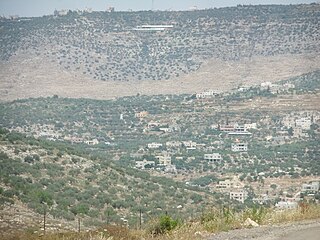
Kafr Rumman is a Palestinian town in the Tulkarm Governorate in the eastern West Bank, located 11 kilometers East of Tulkarm. According to the Palestinian Central Bureau of Statistics, Kafr Rumman had a population of approximately 869 inhabitants in mid-year 2007.
Kafr Zibad is a Palestinian village in the Tulkarm Governorate in the western part of the West Bank, located 17 kilometers south of Tulkarm.

Al-Kasayir was a Palestinian Arab village in the Haifa Subdistrict, located 13 km east of Haifa. It was depopulated during the 1947–48 Civil War in Mandatory Palestine on April 16, 1948, under the Battle of Mishmar HaEmek.

Khirbat Qumbaza was a Palestinian Arab village in the Haifa Subdistrict, located 21.5 km south of Haifa, 3 km away from Wadi al-Milh. It was depopulated during the 1948 Arab-Israeli War in May 1948.

Bayyarat Hannun was a Palestinian agricultural estate in the Tulkarm Subdistrict in Mandatory Palestine. It was depopulated during "Operation Coastal Clearing" on March 31, 1948, in the 1947–48 Civil War in Mandatory Palestine. It was located 16 km west of Tulkarm.

Ghabat Kafr Sur was a Palestinian village in the Tulkarm Subdistrict of Mandatory Palestine. It was depopulated during the 1948 Arab–Israeli War on May 15, 1948, under Operation Coastal Clearing. It was located 16 km southwest of Tulkarm.

Khirbat al-Majdal was a Palestinian Arab village in the Tulkarm Subdistrict. It was depopulated during the 1947–48 Civil War in Mandatory Palestine on March 1, 1948, under Operation Coastal Clearing. It was located 10 km northwest of Tulkarm.
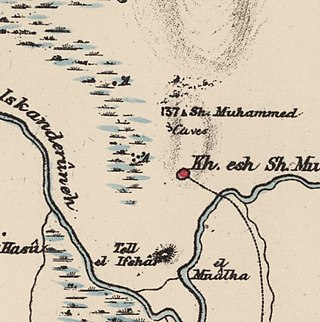
Wadi al-Hawarith was a Palestinian bedouin village in the Tulkarm Subdistrict. It was ethnically cleansed at the outbreak of the 1948 Arab–Israeli War on March 15, 1948, following the 1947–48 Civil War in Mandatory Palestine. It was located 16.5 km northwest of Tulkarm. Wadi al-Hawarith was mostly destroyed with the exception of four houses.

Wadi Qabbani, also known as Khirbat ash Sheik Husein was a Palestinian Arab village in the Tulkarm Subdistrict. It was probably depopulated during the 1947–48 Civil War in Mandatory Palestine on March 1, 1948, as part of Operation Coastal Clearing. It was located 12 km northwest of Tulkarm. The name, Qabbani came from the Lebanese family who owned most of the land.
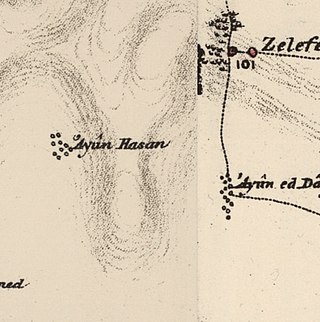
Al-Manshiyya, also known as Khirbat Manshiyya, was a Palestinian Arab village in the Tulkarm Subdistrict. It was depopulated during the 1947–48 Civil War in Mandatory Palestine on April 15, 1948, under Operation Coastal Clearing. It was located 12.5 km northwest of Tulkarm.
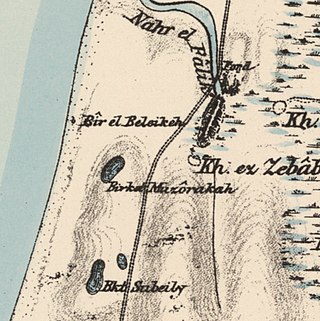
Khirbat al-Zababida was a Palestinian Arab village in the Tulkarm Subdistrict. It was depopulated during the 1948 Arab–Israeli War on May 15, 1948. It was located 20 kilometres (12 mi) southwest of Tulkarm, south of Wadi al-Faliq. Khirbat al-Zababida was mostly destroyed except for four deserted houses.

The Nazareth Subdistrict was one of the subdistricts of Mandatory Palestine. It was located around the city of Nazareth. After the 1948 Arab-Israeli War, the district disintegrated; having fallen entirely within Modern-day Israel, it was merged with the Beisan Subdistrict into the Jezreel Subdistrict.
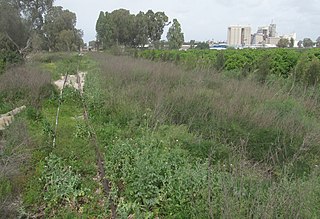
The Eastern Railway refers to a railroad in central Israel stretching from Lod to Hadera. The section between Kfar Saba and Lod, as well as a short section just north of Hadera are currently in use but the rest of the railway has not been operative since 1969. However, in 2019 a large-scale project began to rebuild and upgrade the railway along the entire route.




















